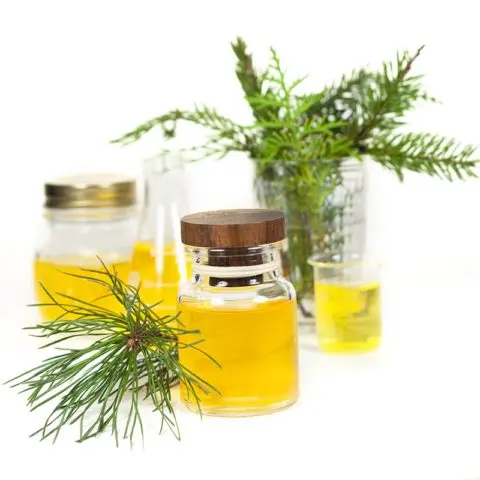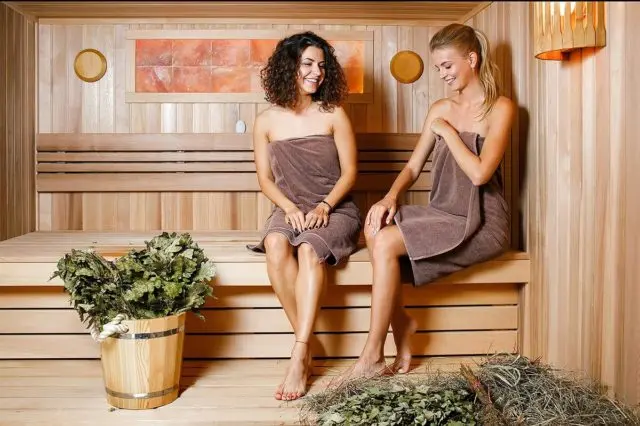Contents
Do-it-yourself fir oil at home is easy to make. A natural remedy saves from many problems – cuts, burns, insect bites, so there are those who want to have it on hand. In some cases, it can have an analgesic effect. But when using it for the first time, it is important to learn about contraindications. One of them is allergic reactions to components.
What does fir oil look like

The resulting product is stored only in glass containers
Fir oil is often used in folk and traditional medicine, as well as cosmetology. The tool has a lot of useful properties, which is why it is so popular. However, safe use requires a quality product, with natural ingredients in the composition. Because of this, many people prefer to make fir oil at home, despite the fact that this is a rather laborious process that requires compliance with the rules.
A quality product has certain properties: color, smell and composition. Any deviation from the norm indicates a violation of the cooking technology, stale raw materials, and this significantly reduces its effectiveness, in some cases it can harm the body.
Composition of fir oil
Useful qualities of the product are due to its constituent elements:
- ascorbic acid;
- tocopherol;
- tannins;
- provitamin A (carotene);
- pinenes (included in the resins of coniferous trees);
- cineole (eucalyptol);
- aldehydes;
- phytoncides;
- camphor;
- oleic and lauric acids.
From macro and microelements, it contains iron, copper, manganese, cobalt.
Due to its rich composition, the product has established itself as an anti-inflammatory and antiviral drug, and is a good antioxidant. The oil has a positive effect on the skin, providing an antibacterial and disinfectant effect.
The smell and color of fir oil
Fir oil is a liquid that may be colorless or have a yellowish, greenish tint. A dark color indicates a poor quality or spoiled product. The smell is rich, coniferous, with hints of lemon and mint. The consistency of the product is also important. It has the ability to quickly absorb and has fluidity. When buying or after cooking at home, you can check its quality by conducting a test. A little oil needs to be applied to the paper. If after 10-15 minutes a greasy spot is noticeable on the surface, then the product is not of high quality and natural.
Does fir oil freeze in the cold
Like all other oils, it undergoes freezing. Thus, by lowering the temperature, crystallization of some components can be detected in the vial. This happens when their concentration goes beyond the saturation point.

The easiest way to prepare is cold pressing.
Types of fir oil
If we talk about fir oil, which is produced on an industrial scale, then there are 3 varieties. Their difference is in what type of fir tree was used in cooking:
- white fir – has a rich woody aroma;
- Siberian fir – a fresh forest smell;
- balsamic fir is a very mild herbal scent.
The main differences are in the aroma, the main thing for raw materials is growing in an ecologically clean place, away from industrial facilities.
How fir oil is made industrially
Fir oil is a valuable resource. In its production, high-quality raw materials and special equipment are used. The best time to harvest it is from May to September. It is during this period that the needles are most saturated with useful substances.
Fir oil is extracted from paws that are no more than 30 cm long and 8 mm wide. Of the equipment, a container (vat) with a grate at the bottom, a chopper that speeds up the production process, a steam generator, as well as a cooling apparatus and a filter are used. Fir oil is driven for no more than 15 hours. At the same time, to obtain 1 liter of the product, 100 kg of coniferous legs and 50 kg of steam are required.
How to make fir oil at home
Making fir oil at home is a rather laborious process, but for connoisseurs of a natural product, it is enough to follow some cooking rules and choose good raw materials. In the future, it will be easier to prepare the liquid. However, it must be borne in mind that in the process the room will be filled with vapors with a strong aroma of needles, which can provoke an asthma attack in allergy sufferers and a headache, especially in children and the elderly.
Collection and procurement of raw materials

Young trees up to 2 m tall are suitable for harvesting raw materials.
It is known that the optimal time for harvesting raw materials is from May to September inclusive. And in the spring it is better to collect young shoots and cones, as well as buds. In August and September, it’s time to shoot the needles. The main condition is that trees should be located as far as possible from the railway, highway, hazardous industries. After collecting raw materials for 1-2 months, it will retain all useful properties.
You need to choose a plant no higher than 2 m in height, which grows in a sunny place and has a healthy appearance. This means the complete absence of signs of dryness, decay, as well as pests, moss. You can collect needles, buds, young green cones, bark. Twigs should be no more than 10 mm in diameter.
How to make fir oil from buds and shoots by infusion
This variant of the preparation of fir oil is called cold pressing. Cut the raw materials and fill the glass jar by 70%, tamp and add oil to the volume. Close with a tight lid. Infuse for about 3 weeks in a dark and cool place (not in the refrigerator). Shake the jar periodically. After 3 weeks, squeeze the resulting mass through cheesecloth and pour into a dark bottle.
How to make fir needle oil in a water bath
For this cooking method, you will need to cut the raw materials into 1-2 cm and put them in a glass jar so that 4-5 cm is left to the edge. Pour the needles with vegetable oil, close the lid and put in a water bath for 5 hours. In this case, you need to monitor the level of water in the container on the stove, periodically adding hot water there. After the contents of the jar have cooled, the plant material must be drained and squeezed. Next, load a new portion and pour strained oil. Again, leave in a water bath for 5 hours. Then strain again and bottle.
The product can be purchased if you do not want to cook it yourself. However, there is a high probability of buying a fake. It is recommended to use trusted manufacturers.
How to cook fir oil in the oven

For raw materials, you can use not only branches, but also young cones and buds
Grind raw materials, put in a glass container, filling it by 80%, add vegetable oil. Wrap with foil on top, make holes. Heat the oven to 150°C and leave the jar for 2 hours. Then reduce the temperature to 60 ° C and simmer for about 10 hours. Cool the contents of the container and strain, add a new portion of needles. The process must be repeated 2 more times. Pour the resulting oil into bottles.
How to make fir oil in a combined way
The technology for making fir oil at home by infusion is quite simple. You will need young buds and shoots. Raw materials should be collected in May, when the intensive growth of the plant begins. The cooking algorithm is as follows:
- Grind raw materials. Cut the kidneys into 2 parts, shoots – into 3.
- Liter jars filled with raw materials up to the shoulders and pour heated refined oil. Top cover with a lid.
- Banks should be left for 40 days in a dark place.
- Strain the mixture, wring out and heat again to 50 °C.
- After cooling, pour into bottles.
The combined method consists in alternating several processes – heating and infusion.
How to make fir oil smell
In the production of fir oil at home, the aroma of a natural product is preserved. Properly made oil smells good. However, over time, the aroma becomes weaker. This is due to the fact that some of the aromatic substances evaporate. To prevent this from happening, you should store the resulting product in a dark, cool place, only in a glass container with a tight lid.
Where is fir oil used
Fir oil has long been known for its beneficial qualities. It is widely used in medicine, cosmetology, since this product is considered natural. It has the following properties:
- antiseptic;
- bactericidal;
- anti-inflammatory;
- painkillers;
- tonic;
- soothing.

Bath lovers use the product for preventive purposes
Fir oil is especially often used for preventive and therapeutic purposes against respiratory diseases, influenza, pneumonia and bronchitis, bronchial asthma. It has a sedative, expectorant effect, relieves inflammation, irritation. The composition includes such useful components as phytoncides, as well as a group of vitamins, which has a general strengthening effect on the body. A good effect is noticeable with hypothermia and frostbite of the skin.
In the treatment of various types of neuralgia and arthrosis, fir oil is shown as an additional therapy, since it has an analgesic effect and actively fights edema. In addition, it has proven itself as a means of influencing the central nervous system. Helps to cope with stress, neurotic disorders, chronic fatigue. It has been shown to help alleviate insomnia.
It can be used only for external purposes, adding to baths, using in compresses, inhalations. Among other things, the product is quite effective for aromatizing and disinfecting the room.
In cosmetology, the drug is used to solve some problems with the skin in the acute stage. These include the treatment of boils, abscesses, acne and edema. The remedy is considered effective for fighting wrinkles, with loss of skin elasticity, and a decrease in turgor. Due to the content of vitamins and minerals in it, it refreshes the face and body, significantly rejuvenates.
Like any product, it has a number of contraindications:
- childhood;
- bronchial asthma;
- tendency to allergic manifestations;
- diseases of the digestive system;
- epilepsy;
- diseases of the urinary system.
In addition, it is necessary to abandon the use of the drug for people with individual intolerance to certain components in the composition, pregnant and lactating women.
If undesirable consequences occur during application, it is recommended to quickly ventilate the room, wash it off the skin surface, rinse your eyes with running water if it gets on the mucous membranes. It is important not to combine with alcoholic beverages, to do an elbow test and not to exceed the recommended dosages.
Why fir oil is used at home

A fir broom for a bath in combination with an extract from needles is the best remedy for many diseases
The tool is so useful that the scope is not limited to human health. It is very functional and widely used in domestic conditions. Fir has a very pronounced aroma, so its oil is often used to repel insects, as well as to relieve itching after their bite.
Essential vapors disinfect the room well, destroying fungi and bacteria, in addition, and unwanted odors. It is successfully used for educational and medical institutions as a harmless air purifier.
How to use fir oil in the bath
It is known that there are a huge number of true lovers of the bath. They are not limited to the usual procedure. For greater effect, many use oils. After visiting the bath, mood and working capacity improve, fatigue disappears, vigor appears in the body. The secret of using oils in baths is that, being volatile substances, molecules penetrate the body much faster under the influence of temperature and humidity. At the same time, the pores on the skin are much better opened, toxins and slags are released, and the beneficial substances in the composition are actively absorbed.
Fir oil is considered one of the first to be used in aromatherapy. In the bath, it is used as follows:
- put a little oil into a bucket of water and sprinkle on the stones, and then inhale the aroma deeply through the nose;
- body massage with a fir broom;
- foot bath.
Any of these procedures will help strengthen the immune system, give a charge of vivacity, protect against respiratory diseases, and tone the skin.
Making soap with fir oil
Real coniferous soap is difficult to buy in a regular store, but you can make it yourself. If it is possible to cook fir oil at home, then it can be used in the preparation of other products. Then the product will turn out completely natural and environmentally friendly.

Fir soap can be prepared independently by adding a couple of drops of oil to the soap base.
In a specialized store you need to buy a soap base, mold, alcohol, fir essential oil. Melt the base, add a few drops of oil there, mix thoroughly, pour. Top must be sprinkled with alcohol, and then left to cool. If, during the preparation process, powdered pine needles are also added to the mass, then the soap will turn out with an exfoliating effect.
Is it possible to drip fir oil on an artificial Christmas tree
To give an artificial Christmas tree a real forest aroma, use the following trick. Clean water is poured into the spray bottle, and 2-3 drops of cinnamon, orange and fir oils are added there. The mixture should be shaken well and sprinkled with an artificial Christmas tree. The aroma is quite rich, so it is important not to overdo it.
As an insect and rodent repellent
Rodents and insects are very difficult to tolerate the smell of fir, so they can be fought with this tool. From mosquitoes and midges can be applied in its pure form, especially in nature. Parasites are attracted to body odor, but fir aroma repels them. Often the oil is used when cleaning the house, adding it to the water. By wiping the surfaces with such a solution, you can protect the house from the invasion of winged insects and cockroaches for a long time.
To get rid of rats and mice, you can use a composition of any vegetable oil with drops of fir. This mixture should be moistened with cotton swabs and spread out in places where rodents appear. After a certain time, the “guests” will stop visiting.
Fir oil for room fragrance
Fir oil is often used as a fragrance by adding it to an air humidifier. A similar natural spray can be made independently. It will provide not only a pleasant aroma in the room, but also health, good mood, cheerfulness. To do this, you can drop a few drops into the spray bottle, mix, and then periodically spray the room.
How to check fir oil for quality

A quality product has a delicate coniferous aroma
The following signs will indicate high quality:
- smell;
- appearance;
- structure and density.
There are several ways to test fir oil for quality. Pour a small amount into a glass container and shake lightly. At room temperature, it should be free of impurities, turbidity. Only a slight sedimentation is acceptable, however, as the temperature rises, the oil should again become transparent.
You can put a few drops on a clean cloth. The smell should be pleasant and light, not irritating to the sense of smell. Over time, the fragrance evaporates and becomes even less noticeable. If flavorings are added, then the smell is quite saturated and does not quickly disappear.
What can replace fir oil
Other coniferous oils have similar properties. For example, spruce, pine, cedar and juniper. They have differences in composition and properties, but in general they can be used instead of fir. All coniferous tree species are ether-bearing. Oils from them are obtained by evaporation of shoots, buds, young bark. They are used in medicine, cosmetology and in everyday life.
Where and how to store fir oil
After preparation, it must be poured into a glass container, preferably dark glass. It is necessary to pick up an airtight lid for this container so that the esters do not evaporate. Store only in a dark, cool place. A refrigerator is fine. Under proper storage conditions, it will not lose its properties within 2 years.
Conclusion
Do-it-yourself fir oil at home is very easy to make, especially by cold pressing. Other methods are more labor intensive. However, the effort is worth it – the product is of high quality and natural without impurities. It is suitable for the treatment of various diseases and as a prophylactic. In addition, many find it effective in solving some everyday problems.









